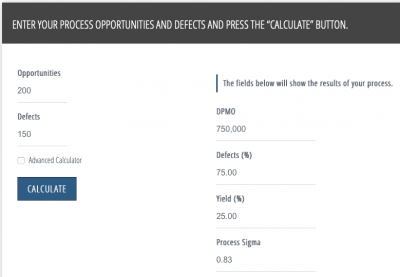
If you’re curious as to what Defects Per Million Opportunities (DPMO) means, how to calculate it, what its benefits are, and how best to use it for understanding the performance of your process, read on.
Overview: What is DPMO?
Let’s start by defining the word defect. A defect is a flaw or discrepancy in a process or object. There can be multiple flaws or defects in an object. For example, an invoice may have a defect or error in the address line, invoiced amount, discount, or delivery date. Each one is an opportunity to make a mistake on the invoice that you send to your customer. Each defect can cause a disruption and upset your customer.
We can then define a defective as an object that has one or more defects that may make the object unacceptable. In our example, your invoice can have up to four different types of opportunities (for defects), which could then define your invoice as a defective invoice.
A downside of using defectives as a measure, is that you can have an invoice with just a small spelling error in the address line, while another invoice might have an incorrect calculation, wrong address, and wrong customer name. Both are defective, but certainly they are not wrong to the same degree.
You can use the defect frequency to calculate something we call DPU, or defects per unit. The formula for that is:

As an example, you could take a sample of 50 invoices, total the count of all defects found in those 50 invoices (assume a total of 150 defects), and then divide that number by your sample size of 50 to get an average estimate of 3 defects per unit or invoice.
DPU = 150/50 = 3
To calculate DPMO, you would use this formula:

If your organization does not produce a large volume of output, you can also calculate defects per thousand opportunities, or defects per hundred opportunities by multiplying by the appropriate number.
Your DPMO value can also be converted to a sigma level value. While there are a number of tables available on the internet, here’s a simple calculator that will do it for you.
Opportunities are found by multiplying your sample of 50 times your 4 possible defects. Defects are the total number of defects you counted in the 50 sample invoices. In your example, that was 150. If you’re striving for a 6 sigma process, you can see that this process, which is at a 0.83 process sigma, is far from achieving that goal.
Note in the sigma table below that if you look for your DPMO of 750,000, it will fall between a Sigma level of 0.80 and 0.85. Using your eyeball, you might extrapolate between those values and get 0.83 which is what the calculator above gave you.

Image source: Six Sigma Study Guide.
3 benefits of DPMO
DPMO is a calculation of the performance of your process. It is descriptive rather than prescriptive.
1. Simple calculation
To calculate your DPMO, you only need three values. First is the sample size you’ve chosen. Second is the number of opportunities or ways you can create a defect. Third is the total number of detected defects in your sample. From there, the math is simple.
2. Generic comparison
Much like Cpk is a generic measure of process capability that allows you to compare processes across a range of functions, DPMO allows you to compare quality and performance across a variety of different processes.
3. Flexibility
Depending on the volume that your process produces, you can also talk in terms of defects per thousand, or hundred — or any quantity of opportunities.
Why is DPMO important to understand?
While simple in calculation, there are a number of things to understand that will make DPMO helpful in your decision-making.
Relative quality level
There are a number of different calculations you can use to evaluate the quality of your process. We previously discussed DPU. You can also use rolled throughput yield (RTY), Cpk, or parts per million (PPM). PPM is generally used in the context of defectives, not defects. All can be used to compare different processes.
Link to sigma level
Many organizations refer to their quality in terms of their sigma level, with the goal being a minimum of a 6 sigma process. DPMO can be converted to the appropriate sigma level.
Holistic view
DPMO forces you to identify the potential fail points in your process that could result in the creation of an unsatisfactory product or service for your customer.
An industry example of DPMO
A large mid west hospital was concerned about an increase in errors while administering drugs to their patients. The chief nursing officer, Nancy, wanted to get a handle on how bad the problem was. She requested that the hospital Process Improvement Office help her carry out her project.
Will, a certified Black Belt, was assigned to help her. The first thing Will did was to ask Nancy to list the different types of mistakes that could happen when administering meds to the patient. She listed these:
- Wrong med
- Wrong patient
- Wrong time
- Wrong dosage
- Wrong route of entry (suppository not oral)
While there were a number of other possibilities, they were excluded as being highly unlikely or realistic.
Will reviewed the medical records for 1,000 patients and counted the number of times an error occurred. He found 75 administration mistakes. There was also the possibility that more than one mistake could have been made on a single patient. Someone could have been given the wrong dosage and at the wrong time.
From there, Will calculated the DPMO for the drug administration process. Here was Will’s calculation:

This translated to a sigma level of 3.67 and a defect rate of 1.5%. Nancy concluded this was a dismal result and unsatisfactory for a process as critical as drug administration. Working with Will, she identified which were the major mistakes using a Pareto Chart and formed a team of nurses, doctors, and pharmacists to significantly reduce the mistakes with a goal of zero mistakes.
3 best practices when thinking about DPMO
Like most of the other process metrics, there are some recommended practices that will help you and your team be successful. Here are a few that will help you stay on track.
1. Be realistic
I’m sure if a meteor strikes your organization’s facility you will produce a defect. But is that realistic? When identifying potential defect types, keep the list manageable, and focus on those defects that could logically occur. Adding everything and anything will give you a false impression of the true underlying process quality.
2. Use an appropriate sample size
Be sure you look at a large enough sample size to allow an identified defect an opportunity to appear.
3. Use clear definitions
Have a clear and measurable definition of what you are selecting as a defect. If you said that a possible defect for drug administration is wrong time, what exactly does that mean? Is it 5 minutes late? Is it administered within a one-hour range? Everyone needs to agree upon the definition.
Frequently Asked Questions (FAQ) about DPMO
How do you calculate DPMO?
It is the total number of defects in a sample divided by the sample size times the number of possible defects that you can have in an item. Multiply that by 1,000,000, and you get DPMO.
What is a good level for DPMO?
A 6 sigma process is defined as having 3.4 defects per million opportunities. That should be a worthy goal to reach for.
What is the relationship between DPMO and sigma level?
As DPMO goes up, your sigma level goes down. The more defects you have, the lower your sigma level will be.
So, what is DPMO?
DPMO is a mathematical calculation of the estimated quality of a process defined as the defects per million opportunities.
We have defined a defect as a flaw or error in an object or process. You will define the possible defects that can occur. Using the calculation for DPMO above, you can get an idea of how often your process is producing defects.
